|
ACID-BASE INDICATORS
This page describes how simple acid-base indicators work, and how to choose the right one for a particular titration. | |||||||||||||||||||||
|
Warning: This page assumes that you know about pH curves for all the commonly quoted acid-base combinations, and weak acids (including pKa). If you aren't happy about either of these things, you must follow these links before you go any further. | |||||||||||||||||||||
|
How simple indicators work Indicators as weak acids Litmus Litmus is a weak acid. It has a seriously complicated molecule which we will simplify to HLit. The "H" is the proton which can be given away to something else. The "Lit" is the rest of the weak acid molecule. There will be an equilibrium established when this acid dissolves in water. Taking the simplified version of this equilibrium: | |||||||||||||||||||||
|
Note: If you don't understand what I mean by "the simplified version of this equilibrium", you need to follow up the weak acids link before you go any further. | |||||||||||||||||||||
|
The un-ionised litmus is red, whereas the ion is blue. Now use Le Chatelier's Principle to work out what would happen if you added hydroxide ions or some more hydrogen ions to this equilibrium. | |||||||||||||||||||||
|
Note: If you don't understand Le Chatelier's Principle, follow this link before you go any further, and make sure that you understand about the effect of changes of concentration on the position of equilibrium. Use the BACK button on your browser to return to this page. | |||||||||||||||||||||
Adding hydroxide ions: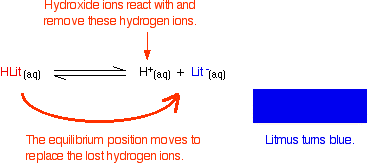 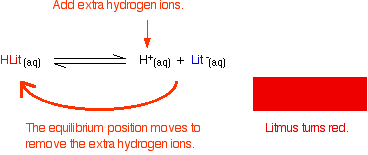 At some point during the movement of the position of equilibrium, the concentrations of the two colours will become equal. The colour you see will be a mixture of the two.  Methyl orange Methyl orange is one of the indicators commonly used in titrations. In an alkaline solution, methyl orange is yellow and the structure is:  In fact, the hydrogen ion attaches to one of the nitrogens in the nitrogen-nitrogen double bond to give a structure which might be drawn like this: 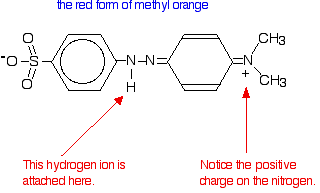 | |||||||||||||||||||||
|
Note: You may find other structures for this with different arrangements of the bonds (although always with the hydrogen attached to that same nitrogen). The truth is that there is delocalisation over the entire structure, and no simple picture will show it properly. Don't worry about this exact structure - it is just to show a real case where the colour of a compound is drastically changed by the presence or absence of a hydrogen ion. | |||||||||||||||||||||
|
You have the same sort of equilibrium between the two forms of methyl
orange as in the litmus case - but the colours are different. | |||||||||||||||||||||
|
Note: If you have problems with this, it is because you don't really understand Le Chatelier's Principle. Sort it out! Use the BACK button on your browser to return to this page. | |||||||||||||||||||||
|
In the methyl orange case, the half-way stage where the mixture of
red and yellow produces an orange colour happens at pH 3.7 - nowhere
near neutral. This will be explored further down this page. Phenolphthalein Phenolphthalein is another commonly used indicator for titrations, and is another weak acid. The half-way stage happens at pH 9.3. Since a mixture of pink and colourless is simply a paler pink, this is difficult to detect with any accuracy! | |||||||||||||||||||||
|
Note: If you are interested in understanding the reason for the colour changes in methyl orange and phenolphthalein, they are discussed on a page in the analysis section of the site about UV-visible spectroscopy. This is quite difficult stuff, and if you are coming at this from scratch you will have to explore at least one other page before you can make sense of what is on that page. There is a link to help you to do that. Don't start this lightly! Use the BACK button (or more likely the HISTORY file or GO menu) on your browser to return to this page much later. | |||||||||||||||||||||
|
The pH range of indicators The importance of pKind Think about a general indicator, HInd - where "Ind" is all the rest of the indicator apart from the hydrogen ion which is given away: Because this is just like any other weak acid, you can write an expression for Ka for it. We will call it Kind to stress that we are talking about the indicator.  | |||||||||||||||||||||
|
Note: If this doesn't mean anything to you, then you won't be able to understand any of what follows without first reading the page on weak acids. Use the BACK button on your browser to return to this page. | |||||||||||||||||||||
Think of what happens half-way through the colour change. At this
point the concentrations of the acid and its ion are equal. In that
case, they will cancel out of the Kind expression. 
Indicators don't change colour sharply at one particular pH (given by their pKind). Instead, they change over a narrow range of pH. Assume the equilibrium is firmly to one side, but now you add something to start to shift it. As the equilibrium shifts, you will start to get more and more of the second colour formed, and at some point the eye will start to detect it. For example, suppose you had methyl orange in an alkaline solution so that the dominant colour was yellow. Now start to add acid so that the equilibrium begins to shift. At some point there will be enough of the red form of the methyl orange present that the solution will begin to take on an orange tint. As you go on adding more acid, the red will eventually become so dominant that you can no longe see any yellow. There is a gradual smooth change from one colour to the other, taking place over a range of pH. As a rough "rule of thumb", the visible change takes place about 1 pH unit either side of the pKind value. The exact values for the three indicators we've looked at are:
This is more easily seen diagramatically. 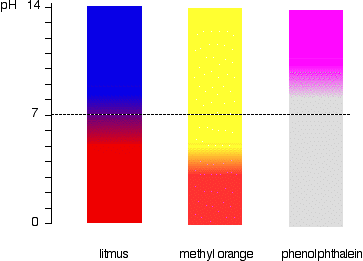 Choosing indicators for titrations Remember that the equivalence point of a titration is where you have mixed the two substances in exactly equation proportions. You obviously need to choose an indicator which changes colour as close as possible to that equivalence point. That varies from titration to titration. Strong acid v strong base The next diagram shows the pH curve for adding a strong acid to a strong base. Superimposed on it are the pH ranges for methyl orange and phenolphthalein. 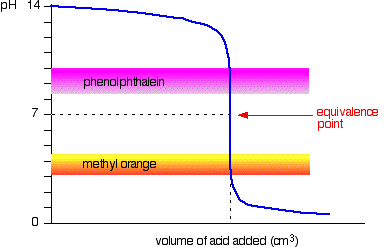 However, the graph is so steep at that point that there will be virtually no difference in the volume of acid added whichever indicator you choose. However, it would make sense to titrate to the best possible colour with each indicator. If you use phenolphthalein, you would titrate until it just becomes colourless (at pH 8.3) because that is as close as you can get to the equivalence point. On the other hand, using methyl orange, you would titrate until there is the very first trace of orange in the solution. If the solution becomes red, you are getting further from the equivalence point. Strong acid v weak base 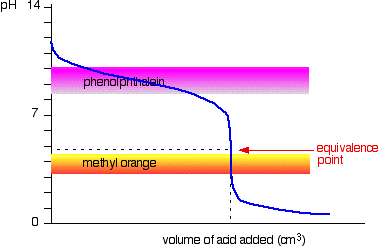 You have to choose an indicator which changes colour on the steep bit of the curve. Weak acid v strong base 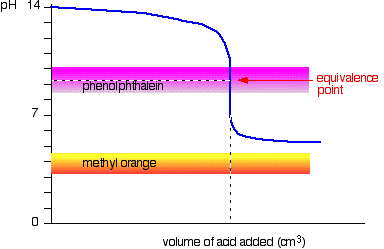 Weak acid v weak base The curve is for a case where the acid and base are both equally weak - for example, ethanoic acid and ammonia solution. In other cases, the equivalence point will be at some other pH. 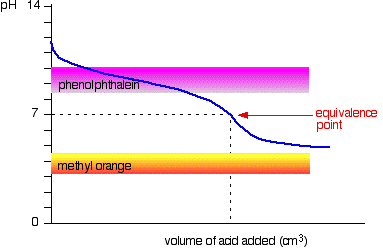 It may be possible to find an indicator which starts to change or finishes changing at the equivalence point, but because the pH of the equivalence point will be different from case to case, you can't generalise. On the whole, you would never titrate a weak acid and a weak base in the presence of an indicator. Sodium carbonate solution and dilute hydrochloric acid This is an interesting special case. If you use phenolphthalein or methyl orange, both will give a valid titration result - but the value with phenolphthalein will be exactly half the methyl orange one. 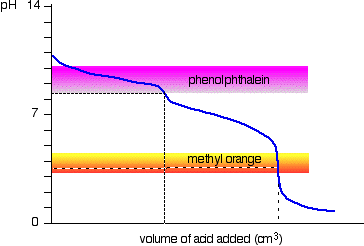 The methyl orange changes colour at exactly the pH of the equivalence point of the second stage of the reaction. | |||||||||||||||||||||
Tuesday, 24 September 2013
ACID-BASE INDICATORS
Subscribe to:
Post Comments (Atom)
No comments:
Post a Comment